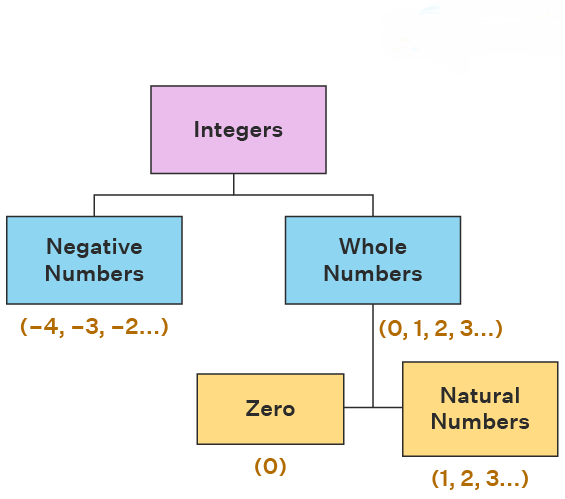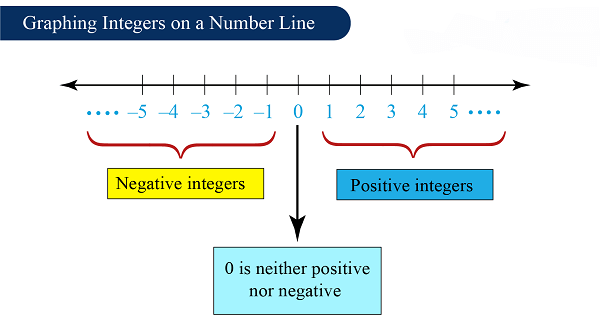Integers Definition and ExamplesWhat is an IntegersIt is a set of wholes containing all positive and negative numbers devoid of fractional or decimal parts. The letter used for the denoting Integer is Z, and it includes ( -10, -9, -8, -7, -6, -5, -4, -3, -2, -1, 0, 1, 2, 3, 4, 5, 6, 7, 8, 9, 10) Integers are used for conducting mathematics operations such as addition, subtraction, multiplication, and division. Integers are used in diverse fields such as economics, mathematics, computer programming, and science. 
Types of Integers
Representation of the Integers on the Number Line
It has already been mentioned that three types of integers exist, and it is very easy to represent them on the number line depending upon the negative and positive integers on the zero. Zero is sitting in the center of the number line. Positive integers are placed on the right side of the zero, and negative integers are placed on the left side of the zero. Rules of the Integers
Since integers are whole numbers, they can be Zero, Negative and positive. They abide by specific rules and properties that control their behavior in mathematic operations. Some general rules used in the integers are: 1. Addition of Integers
When two positive numbers are added, the result is a positive integer. For example 4 + 3 = 7 7 + 3 = 10
When two negative numbers are added, the given result would be negative integers. For say (-3) + (-4) = (-7) (-5) + (-5) = (-10)
When a positive integer is added to a negative integer, the result will be based on the magnitude of the number. If a positive number is greater, the result would also be positive. If the negative integer has a larger magnitude, the result would be a negative integer. For example (-6) + 7 = 1 (-8) + 4 = -4 2. Subtraction of Integers
This mathematical operation executes by subtracting the smaller integer value from the large value of the integer. The sign of the result is equal to the larger integer. On the other sense, x - y = z, where x > y for example, 7 - 6 = 1.
To subtract a positive integer from a negative integer, the positive integer should be added to the absolute value of the negative integer and keep the positive sign of the result. In other words, x - (-y) = z where z > 0. For example, 4 - (-5) = 9
For the subtraction of two negative numbers, change the subtraction operation to the addition, alter the sign of the second negative integer to positive, and then carry out the addition as usual. In another sense, -a - (-b) = c where a > 0 and b > 0. For example, -7 - (-3) = -4 Above are the rules for the subtraction of the integers. It is crucial to understand the working of the sign of the integers during subtraction to perform the operation correctly and get the correct result. 3. Multiplication of the IntegersThe rules which are observed in the multiplication of the integers:
In the multiplication of two positive integers, use simple multiplication rules, and the result will be a positive integer. In another sense, xb = z, where a > 0 and b > 0. For example, 5 * 4 = 20.
For the multiplication of the positive integers by negative integers, multiply them together, and the result obtained will be a negative integer. This can be illustrated: a x (-b) = -c, where a > 0 and b > 0 Example: 5 x (-2) = -10
For the multiplication of a negative integer by a positive integer, multiply them together, and the result obtained will be a negative number. This is illustrated below (-a) x b = -c, where a > 0 and b > 0 Example: (-3) * 6 = -18
Multiplying two negative numbers together, and the result obtained will be a positive integer. This is illustrated below. (-a) x (-b) = c, where a > 0 and b > 0 Example: (-2) * (-3) = 6
The result will always be zero when a number is multiplied by zero. It is independent of the sign of the integer.In other words: x 0 = 0, where a is any integer Example: 7 x 0 = 0 Above are the rules for the multiplication of the integer. It's important to understand these rules to perform multiplication operations with integers correctly and obtain the correct results. 4. Division of the Integers
Normal Division: Divide the dividend by the divisor. When the two positive integers are given, the result obtained from the operation will be a positive integer or will be in the form of a fraction. In other words: a / b = c, where a > 0 and b > 0 Example: 8 / 4 = 2
Divide the dividend by the negative integer, and the result obtained from the operation will be a negative integer or a fraction. This can be illustrated as: a / b = c, where a > 0 and b > 0 Example: 12 / -3 = -4
Divide the dividend by the positive integer. The result obtained will be a negative integer. For example a / b = c, where a > 0 and b > 0 -8/(4) = -2
The result always turns positive when the division occurs between two negative integers. a / b = c, where a > 0 and b > 0 -8/ -4 = 2 Some Main Properties of Integers1. Commutative PropertyThe commutative property governs the addition of the integers. It implies that when the order of the integers when they are added, it does not affect the result. a+b=b+a 4+ 5 =5+4 9=9 2. Zero PropertyAdding the value of zero to the integer does not alter the value of the integer. For example 4 + 0 = 4 (-3) + 0 = (-3) 3. Associative PropertyThe law of the associative property also governs the addition of the integers. The property states that adding the number to the group does not alter the result. (6 + 7) + 5 = (7 + 5) + 6 18=18 4. Identity Property of the IntegersThe identity element property of the integers says that a unique property character exists, referred to as an "identity element" or additive identity, such as that when a number is added to it, the outcome would be the result itself. We can understand that identity characteristic is a characteristic that does not alter the value of the other elements when added to them. Mathematically, the identity element property of addition can be expressed as follows: For any integer 'a', a + 0 = 0 + a = a This is valid for all integers, such as positive, negative, and zero. Multiplicative Inverse of an IntegersThe multiplicative Inverse of a non-zero integer is a number that, when a number is multiplied by the original integer, gives the product of 1. In other words, for an integer "a," its multiplicative inverse "b" is such that "a" multiplied by "b" equals 1. The presence of the multiplicative Inverse relies upon the original integer being zero. For the non-zero integers, a unique multiplicative inverse exists, which is also an integer. However, for the integer 0, there is no multiplicative inverse, as division by zero is undefined in mathematics. Formally, for a non-zero integer "a," its multiplicative inverse "b" can be expressed as: a * b = 1 Solving for "b" gives: b = 1/a For example, let's consider the integer 4. The multiplicative inverse of 4 would be 1/4, because 4 multiplied by 1/4 equals 1: 4 * (1/4) = 1 Similarly, the multiplicative inverse of -2 would be -1/2, because -2 multiplied by -1/2 also equals 1: -2 * (-1/2) = 1 The point should be remembered that all integers do not contain any multiplicative inverse. For example, no integer value may be multiplied by 0 to produce 1. Therefore, 0 will not be considered a multiplicative inverse.
Next TopicFertile Definition
|
 For Videos Join Our Youtube Channel: Join Now
For Videos Join Our Youtube Channel: Join Now
Feedback
- Send your Feedback to [email protected]
Help Others, Please Share










